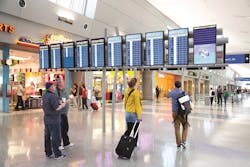McCarran Invests In Digital Signage To Engage Las Vegas Travelers
Back in the 1940s, when the main airport in Las Vegas shuttled approximately 1.5 million passengers in and out of the city each year, it probably wasn’t too hard for visitors to find their way around the airport. Today, Las Vegas is one of the top vacation destinations in the world, with McCarran International Airport welcoming more than 114,000 passengers every day.
In order to properly serve the growing number of visitors to the city, McCarran started construction in 2007 on a new 1.9-million-square-foot, $2.4 billion terminal that would host international and domestic flights. The five-year project was completed in 2012, as McCarran’s Terminal 3 (T3) opened its doors on June 27.
The new terminal is decked out with state-of-the-art amenities along with 14 new gates – seven of which are dedicated to international flights.
“Employing 1,800 people at its peak, the McCarran T3 project positions Las Vegas for the demanding growth in international and domestic travel, and our region as the premier tourist destination,” said David Bourgon, manager of airport IT services at McCarran Airport.
While McCarran’s expansion helps the airport to deal with the 41 million+ passengers that pass through the airport each year, it also created a challenge – all that additional space makes getting people to the right place at the right time a daunting task. In addition to flight arrival and departure times, the airport needs to provide visitors information on baggage and gates, how to get from one section of the airport to another (i.e. wayfinding) and directories with information on local places of business and points of interest.
Based on past experience, Bourgon knew that the best way to streamline this process was through the use of digital signage, and the airport invested in digital signage in a big way, installing more than 900 large-screen displays throughout T3. This included 182 46” displays and 723 40” displays.
Before undertaking an installation of this magnitude, there were a number of factors that airport personnel had to take into consideration.
Bourgon says that the main function for digital signage at McCarran is to provide wayfinding information and to gain as much flexibility as possible for IT staff who constantly convey information updates to travelers.
The ability to make changes at a moment’s notice is a top consideration for an airport environment, according to Bourgon: “T3 is home to a number of airlines, but not all airlines use the terminal every day. For example, United might not have any flights scheduled to arrive in or depart from T3 today, but they will have a number of flights tomorrow. Using digital signage, we can easily change information on the fly to keep our guests informed. With static signage, that becomes a laborious task.”
Randall H. Walker, the director of aviation for Clark County, who oversees McCarran in his role, said that one of its goals with the digital signage installation was to ensure that modern, helpful amenities were in place for travelers. Using digital displays with embedded software “allows us to do just that by offering a wide variety of useful information via any single interactive sign. This helps patrons better navigate the airport and learn about factors affecting their travels,” he said.
Through the digital displays, travelers are able to easily find information about shopping, dining, airport clubs and other airport amenities. A “map it” feature also enables travelers to see an animated visual route from their current locations to their destinations as well as turn-by-turn directions. The directions can then be easily sent from one of the interactive displays to a traveler’s smartphone through the use of QR codes.
In addition to providing wayfinding, digital displays also are a great option for delivering other important information to travelers. McCarran uses displays at each gate for real-time flight information along with weather forecasts for Las Vegas and destination cities. These displays present iconic photo backgrounds of travel destinations. To remind travelers of the excitement of Las Vegas, synchronized advertising videos are set to play at the top and bottom of the hour on video walls at every gate in T3, which includes video of falling die and active slot machines.
Another key factor that has to be considered for a digital display installation is the rigorous demands an airport puts on the monitors. Just like the casinos Las Vegas is known for, McCarran operates 24/7.
These demands aren’t something that a typical consumer TV can handle, and it is very likely that if installed, they would reach the end of their useful lives within a year. Displays used in an airport setting have to be commercial-grade units that are durable and can be depended upon for the long haul.
Before selecting the types of displays that will be used for an airport installation, aesthetics and maintenance also have to be considered.
At McCarran, Bourgon and his team decided on using displays that could be installed with single-board computers. The computers reside in the expansion slots of the units, and having the ability to house the computers inside the displays helps reduce labor costs.
Ordinarily, the source computers for flight information displays are mounted high on walls or in the air on pedestals. The single-board computer is a compact device that is entirely removable, which means the entire display no longer needs to be removed. IT administrators also can handle diagnostic tests, install upgrades, and view and control digital display content remotely.
In terms of appearances, the computers eliminate the need for an external PC, cabling, mounting and power supplies – video, stereo audio and power are all passed internally from the display to device. The result is that there is very little cabling necessary for these units, so there is no wiring to be hidden. In fact, the only cable necessary is the power cord.
Terminal 3’s addition to McCarran Airport is a bold project set to help make Las Vegas a top tourist destination in the world. Digital signage technologies are helping pave the way.
Clark Brown is Senior Vice President, Sales at NEC Display Solutions (www.necdisplay.com). He can be reached at [email protected].
Clark Brown will be a Digital Signage Expo 2013 speaker presenting this topic in the Vertical Industry Discussion Group on Thursday, 2/28: www.DSEnow.com.


